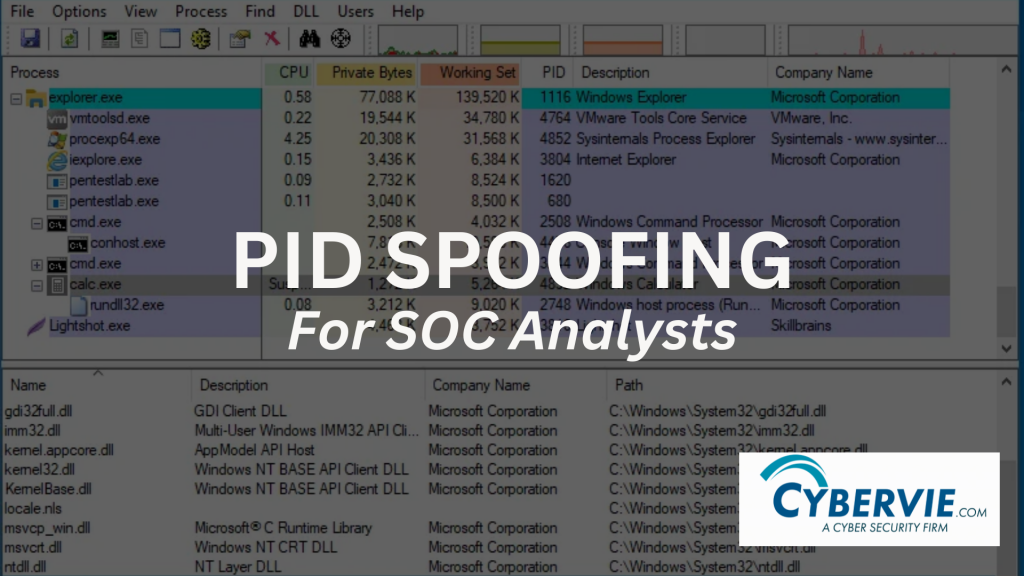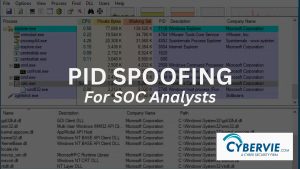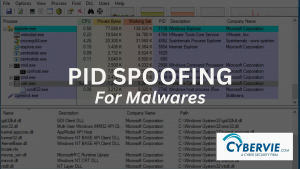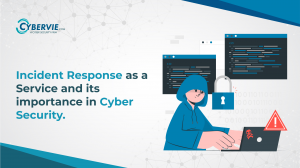Defending against PID Spoofing
In the ever-evolving landscape of cybersecurity, identifying and thwarting sophisticated threats like PID (Process ID) spoofing is paramount. This blog delves into the intricacies of detecting PID spoofing in Windows systems, offering comprehensive strategies and insights from a Blue Team perspective.
To defend you must know how it works, for that red-team perspective refer my previous article .
What is PID Spoofing
PID spoofing is a deceptive tactic utilized by malicious actors to manipulate Process ID Information within Windows environments. By manipulating process relationships, attackers aim to evade detection, gain unauthorized access, and execute malicious activities, posing significant risks to organizational security. For understanding how this is achieved there is a simple POV on red teami over here.
The Blue Team’s Defensive Arsenal
To effectively counter PID spoofing and similar threats, Blue Teams employ a robust toolkit rooted in system-level analysis and monitoring. Central to this arsenal is the utilization of the Windows API coupled with C++ programming capabilities, enabling deep visibility into process hierarchies and system behaviour.
POV with C++ and the Windows API
C++ serves as a cornerstone in the Blue Team’s defensive strategy, offering unparalleled control and insight into Windows internals through direct interaction with the Windows API. By leveraging functions such as CreateToolhelp32Snapshot, Blue Team developers gain access to real-time process information, including Process IDs (PIDs), parent-child relationships, and key system events. The core of PID spoofing detection lies in meticulously examining parent-child PID relationships for anomalies. Blue Teams utilize custom C++ solutions to implement sophisticated anomaly detection algorithms, flagging suspicious behaviour indicative of PID spoofing attempts or can customize EDRs for this. This proactive approach enables rapid threat identification and response, minimizing potential damage.
Here is a simple script to raise alert whenever a new process pops.
#include <iostream>
#include <windows.h>
#include <TlHelp32.h>
#include <unordered_set>
// Global variable to store existing process IDs
std::unordered_set<DWORD> existingProcessIDs;
// Function to raise an alert when a new process is detected
void raiseAlert(DWORD pid, const char* processName) {
// Here you can implement your alert mechanism
// For example, you can print a message to the console
std::cout << "Alert: New process detected! PID: " << pid << ", Name: " << processName << std::endl;
// You can replace this with your custom alerting logic, such as sending an email, logging to a file, etc.
}
// Function to check for new processes and raise alerts if any
void checkNewProcesses() {
// Create a snapshot of the current processes
HANDLE snapshot = CreateToolhelp32Snapshot(TH32CS_SNAPPROCESS, 0);
if (snapshot == INVALID_HANDLE_VALUE) {
std::cerr << "Error: Unable to create process snapshot\n";
return;
}
PROCESSENTRY32 processEntry;
processEntry.dwSize = sizeof(PROCESSENTRY32);
// Retrieve information about the first process in the snapshot
if (!Process32First(snapshot, &processEntry)) {
CloseHandle(snapshot);
std::cerr << "Error: Unable to retrieve process information\n";
return;
}
// Iterate through all processes in the snapshot
do {
DWORD pid = processEntry.th32ProcessID;
const char* processName = processEntry.szExeFile;
// Check if the process ID is new by checking if it exists in the set of existing process IDs
if (existingProcessIDs.find(pid) == existingProcessIDs.end()) {
// New process detected, raise an alert
raiseAlert(pid, processName);
}
// Add/update the process ID in the set of existing process IDs
existingProcessIDs.insert(pid);
} while (Process32Next(snapshot, &processEntry));
CloseHandle(snapshot);
}
int main() {
// Continuously check for new processes
while (true) {
checkNewProcesses();
Sleep(5000); // Sleep for 5 seconds before checking again (adjust as needed)
}
return 0;
}
Best Practices for Robust Defence
Blue Teams can strengthen their defences against PID spoofing and related threats by adopting best practices, including :
- Regular monitoring of process activities and PID relationships using C++ and the Windows API.
- Implementation of advanced anomaly detection algorithms and heuristic analysis to identify suspicious behaviour.
- Integration of automated monitoring tools with manual analysis for comprehensive threat assessment and response.
- Continuous education and awareness of evolving cybersecurity trends and threat intelligence to adapt defence strategies effectively.
Conclusion
Detecting and mitigating PID spoofing in Windows demands a proactive and multifaceted approach from Blue Teams, leveraging C++ programming expertise and deep system-level insights provided by the Windows API. Through continuous innovation, vigilance, and collaboration, Blue Teams uphold the integrity of organizational cybersecurity, ensuring a resilient defences posture against evolving threats.
We are the experts, you need to defend yourself. For more contact Cybervie at info@cybervie.com .

Credits : @erilycus








